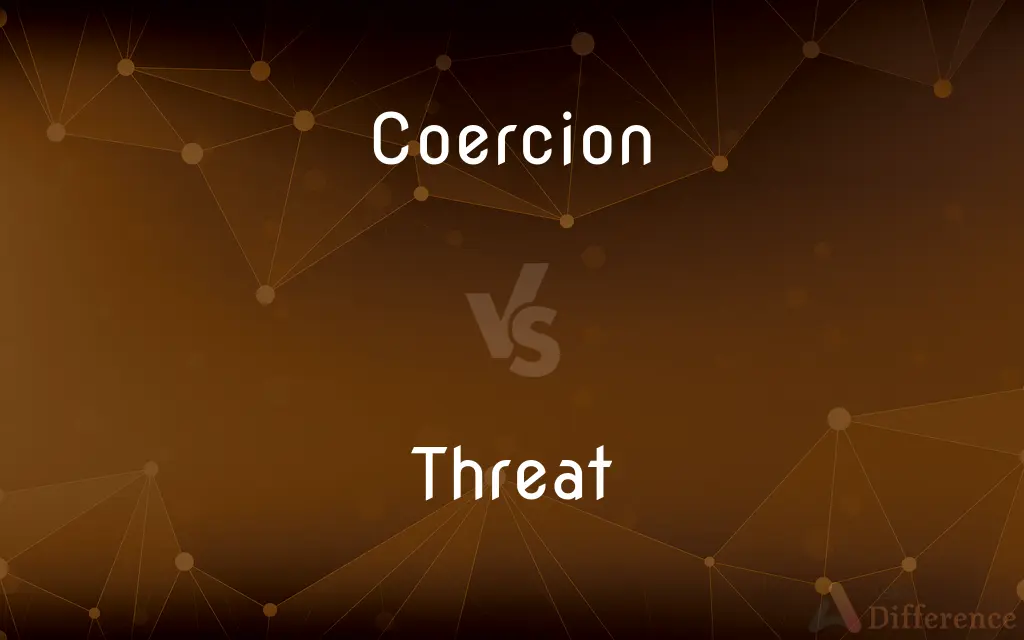Coercion vs. Threat — What's the Difference?
By Tayyaba Rehman & Fiza Rafique — Updated on May 5, 2024
Coercion involves compelling someone to act against their will using force or threats, while a threat is a declaration of intent to inflict harm or loss.

Difference Between Coercion and Threat
Table of Contents
ADVERTISEMENT
Key Differences
Coercion typically implies the use of force or threats to influence someone's actions or decisions. Whereas a threat might not involve immediate action, serving more as a warning or declaration of potential harm.
In legal contexts, coercion is recognized as an undue influence that can invalidate contracts if it interferes with an individual's free will. On the other hand, a threat may not necessarily void legal agreements unless it rises to the level of coercion.
Coercion can be subtle and manipulative, involving psychological strategies to force compliance. In contrast, a threat is often more straightforward and explicit about the negative consequences.
While coercion can involve physical force or the threat of harm, threats alone might not always imply physical force but can include other forms of harm, such as reputational damage or financial loss.
Coercion is often seen in scenarios where there is a power imbalance, such as between an employer and employee. Threats, however, can occur in various situations and can be made by anyone, regardless of their power or position.
ADVERTISEMENT
Comparison Chart
Definition
Using force or threats to influence actions.
A declaration to cause harm or loss.
Legal Implication
Can invalidate agreements if proves undue.
May not void agreements unless coercive.
Nature
Often involves physical force or severe threats.
Can be non-physical like financial threats.
Transparency
Subtle and manipulative.
Generally explicit and clear.
Context of Usage
Common in power imbalances.
Can occur in any context.
Compare with Definitions
Coercion
Employing threats to achieve compliance.
They used coercion by threatening his family.
Threat
Declaring intention to cause physical harm.
The threat was taken seriously by the authorities.
Coercion
Forcing action through legal or social pressure.
The law was used as a tool of coercion against protestors.
Threat
General expression of intent to harm or punish.
The threat alone was enough to silence critics.
Coercion
Involving power imbalances to enforce decisions.
The manager’s coercion got him the undesired transfer.
Threat
Using verbal warnings to influence behavior.
She faced a threat if she did not comply.
Coercion
Using physical force to control actions.
He was coerced into signing the contract under duress.
Threat
Suggesting reputational damage to intimidate.
He used the threat of public exposure as leverage.
Coercion
Manipulating someone psychologically for consent.
Coercion involved promises of harm if she spoke out.
Threat
Imposing potential financial losses as leverage.
The threat of a lawsuit forced them to settle.
Coercion
Coercion () is compelling a party to act in an involuntary manner by use of threats, including propaganda or force. It involves a set of various types of forceful actions that violate the free will of an individual to induce a desired response, for example: a bully demanding lunch money from a student or the student gets beaten.
Threat
An expression of an intention to inflict pain, harm, or punishment.
Coercion
The act or practice of coercing.
Threat
An indication of impending danger or harm
A threat of frost in the air.
Coercion
Power or ability to coerce.
Threat
One that is regarded as a possible source of harm or danger
Viewed the stranger as a threat to the community.
Coercion
(uncountable) Actual or threatened force for the purpose of compelling action by another person; the act of coercing.
Threat
The condition of being in danger or at risk
Under threat of attack.
Coercion
Use of physical or moral force to compel a person to do something, or to abstain from doing something, thereby depriving that person of the exercise of free will.
Threat
To threaten.
Coercion
(countable) A specific instance of coercing.
Threat
An expression of intent to injure or punish another.
Coercion
Conversion of a value of one data type to a value of another data type.
Threat
An indication of potential or imminent danger.
Coercion
The process by which the meaning of a word or other linguistic element is reinterpreted to match the grammatical context.
Threat
A person or object that is regarded as a danger; a menace.
Coercion
The act or process of coercing.
Threat
(transitive) To press; urge; compel.
Coercion
The application to another of either physical or moral force. When the force is physical, and cannot be resisted, then the act produced by it is a nullity, so far as concerns the party coerced. When the force is moral, then the act, though voidable, is imputable to the party doing it, unless he be so paralyzed by terror as to act convulsively. At the same time coercion is not negatived by the fact of submission under force. "Coactus volui" (I consented under compulsion) is the condition of mind which, when there is volition forced by coercion, annuls the result of such coercion.
Threat
To threaten.
Coercion
The act of compelling by force of authority
Threat
(intransitive) To use threats; act or speak menacingly; threaten.
Coercion
Using force to cause something;
Though pressed into rugby under compulsion I began to enjoy the game
They didn`t have to use coercion
Threat
The expression of an intention to inflict evil or injury on another; the declaration of an evil, loss, or pain to come; menace; threatening; denunciation.
There is no terror, Cassius, in your threats.
Threat
To threaten.
Of all his threating reck not a mite.
Our dreaded admiral from far they threat.
Threat
Something that is a source of danger;
Earthquakes are a constant threat in Japan
Threat
A warning that something unpleasant is imminent;
They were under threat of arrest
Threat
Declaration of an intention or a determination to inflict harm on another;
His threat to kill me was quite explicit
Threat
A person who inspires fear or dread;
He was the terror of the neighborhood
Common Curiosities
Is coercion always illegal?
Not always, but it can be illegal if it involves criminal acts or violates civil rights.
What is coercion in a legal sense?
Coercion in law refers to forcing someone to act in a way by using threats or physical force.
How can one prove coercion in court?
Evidence of threats, recordings, or witness testimony can prove coercion.
What types of threats are commonly used in coercion?
Physical harm, financial loss, and reputational damage are common.
Are threats considered a criminal act?
Threats can be criminal if they imply serious intent to harm or illegal actions.
Can a threat become coercion?
Yes, if a threat limits someone’s free will and leads to forced actions, it can be seen as coercion.
Are all threats explicit?
No, some threats can be implied through tone, context, or past behavior.
Can employers legally coerce employees?
While influence is common, coercion crossing into abuse of power is illegal.
How does a threat differ from coercion?
A threat is an expressed intent to harm, while coercion involves actual steps to force compliance.
What is psychological coercion?
It involves manipulating someone’s thoughts or feelings to gain control.
What are the effects of threats on behavior?
Threats can induce fear, compliance, or preventive actions from the threatened.
Can threats without action be harmful?
Yes, the psychological impact of threats alone can be significant.
What legal defenses are there against coercion?
Proving coercion can lead to nullifying contracts or reducing penalties.
How does societal coercion manifest?
Societal coercion can appear through norms, expectations, or legal pressures.
Share Your Discovery

Previous Comparison
Spirt vs. Spurt
Next Comparison
Parmesan vs. CotijaAuthor Spotlight
Written by
Tayyaba RehmanTayyaba Rehman is a distinguished writer, currently serving as a primary contributor to askdifference.com. As a researcher in semantics and etymology, Tayyaba's passion for the complexity of languages and their distinctions has found a perfect home on the platform. Tayyaba delves into the intricacies of language, distinguishing between commonly confused words and phrases, thereby providing clarity for readers worldwide.
Co-written by
Fiza RafiqueFiza Rafique is a skilled content writer at AskDifference.com, where she meticulously refines and enhances written pieces. Drawing from her vast editorial expertise, Fiza ensures clarity, accuracy, and precision in every article. Passionate about language, she continually seeks to elevate the quality of content for readers worldwide.
















































